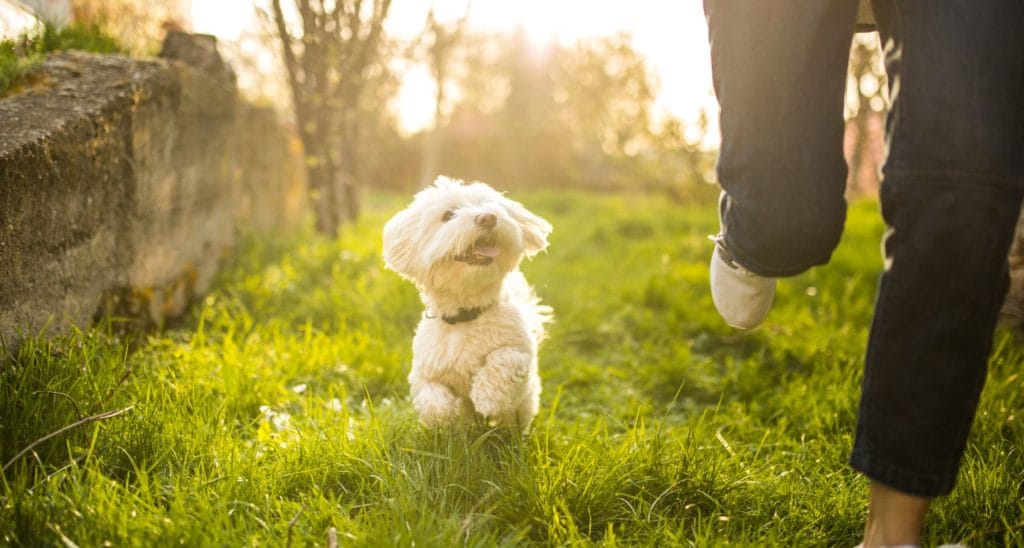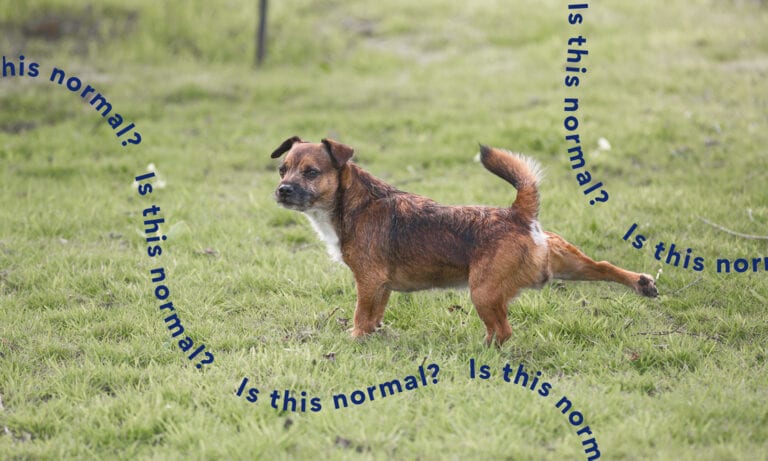Raising a dog who is shy or fearful can make it difficult to go to new places or experience new things together. But worry not. Building confidence in dogs takes some work, but it can make new experiences less daunting.
So how do you build confidence in a dog? First, determine if they are shy or fearful by looking at your dog’s body language, says Dr. Patrick Melese, a board-certified veterinary behaviorist at Veterinary Behavior Consultants in San Diego, California.
“It’s most obvious when a dog is showing body signals of fear: tucked tail, ears back, avoidance, shaking, trying to hide, things that most people clearly would recognize as an avoidance and a fear behavior,” says Melese.
Additional signs you should look out for include panting, lip licking, shaking off, dropping his tail and maybe even crouching. Fearful dogs may also check in often with their owners or, if they are extremely afraid, may become aggressive to make the source of their fear go away, says Dr. Liz Stelow, a behavior clinician at the UC Davis Veterinary Medical Teaching Hospital in Davis, California.
From allowing your dog to observe other dogs, to putting your pooch in a new environment the right way, here are six ways to help boost your dog’s confidence:
1. Try Exposure Management

iStock.com/darrya
This tip sounds fancy, but it’s not. You’re essentially finding ways to rewire your dog’s brain to associate something they were once afraid of with something the love. Let’s say your dog is afraid of skateboards. Try placing a skateboard on the floor with dog treats sprinkled on it.
“The dog’s going to investigate and realize, ‘Oh, wait a minute, this could be a moving tray with treats.’ In effect, you’re trying to help change the dog’s opinion of this,” says Melese.
Once the dog is comfortable with the stationary skateboard, try moving it one inch with the treats on top. Once the dog is no longer fearful of the skateboard moving slightly, start moving it more until mimics what they might find in real life: a moving skateboard with someone on it.
This technique reprograms the dog’s response through a combination of managing the exposure (so that you don’t have the dog constantly reacting to that same thing) then reintroducing the stimulus (the thing that is scaring the dog) in a controlled manner and associating it with positive experiences, like food, says Melese. He adds that for this technique to be effective, the treat needs to be high value (consider small pieces of cheese or boiled hot dog).
2. Find an Environment Where the Dog Can Be Successful

iStock.com/hobo_018
Sitting in your home and dwelling on what might go wrong isn’t beneficial for your mind, and the same goes for your dog. If you can find a way to put them in a new environment where they feel more excited or happy, go for it.
“Go hiking in places where the dog is spending more time in a really fascinating environment with all sorts of smells and sights,” says Melese. “The dog will think, ‘I’m way too busy investigating this cool hike than I am worried about things going bump in the night.’”
This can help dogs learn to spend less time feeling anxious and more time being curious and happy. However, Melese says that this approach might not work for every dog. Some dogs might not feel comfortable in an environment like the wilderness, so try to find a place where your dog can feel better about themselves.
“Generally, the thought is that you don’t want animals spending a lot of time practicing problem behaviors, if you can avoid it,” he says. “This is how we try to reprogram: it’s not that big, it’s not that scary, it’s not that close, it’s not that loud.”
3. Take Up Agility Training

iStock.com/s5iztok
Agility training usually involves teaching your dog certain tasks (like jumping over a pole or running through a plastic tube) then completing those tasks in a specific order. Your dog might be learning new skills, but this really is a trust exercise.
“You start doing these things in a gentle, appropriate way so the dog is beginning to learn to take cues from their human and trust them more,” says Melese. “The dog learns that, ‘I just have to listen to my person, do what that they told me, and it’s awesome.’”
By learning to successfully complete new obstacles, your dog will begin to have more faith in themselves. When you help expand other parts of your dog’s life, Melese says, they begin to realize that they can handle things and surmount those issues that they once thought to be major obstacles.
4. Don’t Forget Obedience Training

iStock.com/Zbynek Pospisil
Teaching your dog skills—like how to sit, lay down or come—can be beneficial for two primary reasons when it comes to confidence building, according to Melese.
Obedience training is helpful because it allows you to develop a language with your dog, which helps you guide your dog to successful behaviors, he says. Once you’ve developed this language, through both commands and body language, you can work on directing your dog’s behavior to something more appropriate when they are feeling fearful.
It’s also helpful because it helps build trust between you and your dog, and gaining your dog’s trust can help you make them feel more safe in his environment. Once you have a background in obedience training developed, you’ll be able to direct your dog more easily, even when they’re feeling a bit worried or anxious, Melese says, and the thing that might’ve once scared him won’t anymore.
5. Introduce New Situations and People Slowly

iStock.com/Constantinis
“If the dog warms to things slowly, always take time introducing something new, especially new settings, people, and other dogs,” says Stelow.
She suggests giving your dog treats for exploring new settings or meeting new people to teach them that new experiences and people can have a positive effect. Similarly, when your dog is meeting people for the first time, remind the people to go slowly and let your dog set the pace for their interaction.
6. Try Allowing Your Dog to Be Around Another Dog

iStock.com/alexei_tm
For some dogs, spending time with another dog can help boost confidence, Melese says. Dogs who are open to these types of interactions will see appropriate behavior modeled for them and think, “I’ve got to try this, this looks like fun,” he says.
However, this approach only works with certain dogs, and its success will largely depend on your dog’s personality as well as the dog they’re introduced to.
The best way to ensure your dog feels confident? Start when they’re a puppy. When your puppy is 8 to 10 weeks old, Melese recommends exposing them to all of the experiences that are going to be a normal part of their everyday life, including other people, dogs, children, street noises and a variety of different surfaces to walk on.
And if you have an older pooch, remember to be patient as you work on building confidence. In dogs, the old cliché—that practice makes perfect—is true.
We hope these techniques will help your dog become more confident. But before modifying your dog’s behavior, keep in mind that these confidence-boosters will only work if your dog is only slightly fearful or shy. Depending on the severity of your dog’s fear, seeking professional help might be your best bet.
“Unless the shyness or fear is very mild, owners should not try to treat it themselves. Instead, they should seek the guidance of a qualified professional. If they choose a trainer, it should be someone who will use only positive, non-aversive methods to accomplish the goals,” says Stelow. Likewise, if the shyness or fear is a new behavior, it’s best to book a trip to the vet to rule out a medical condition.
If your dog doesn’t seem to respond to these tips, or is aggressive in any way, it’s best to back off. If an owner makes their dog do something after he clearly says “no,” it might make the owner themselves another source of fear, Stelow says.
Teresa K. Traverse is a Phoenix-based writer, editor, traveler and dog mom to Chihuahuas Autumn and Rocket.
Share:









